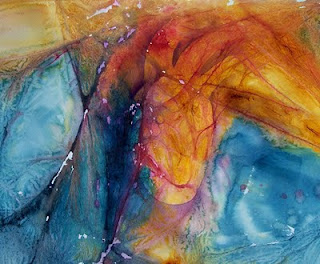So later, studying anthropology, when I learned of corn's importance in early agriculture, I wasn't surprised at all. It seemed a matter of course.
Quilts were another everyday feature of life when I was young. One grandmother pieced quilt tops, the other made embroidered and appliqued quilts. Later, my mother began to piece tops. She and I spent many hours searching for antique pieced tops that she later made into quilts for the family. Quilts combined necessity with strong design and beauty.
In the mid-1990's, I began to create a series of collages based on antique quilt patterns. Maggie Malone's "1001 Patchwork Designs" has been inspirational for me ever since. I like to look for patterns that might work well together, as well as communicate something to my viewers.
"Corn, Beans and Squash"
I began by combining two patterns -- "Corn & Beans" and "Squash Blossom," using colors of sky and cornfield. Then using a simple Native American corn plant design, I began to paint corn stalks in a semi-opaque green on top of the quilt design. The result wasn't good -- somehow it didn't make a strong design statement and the corn plants sure weren't a good focal point. It needed something more -- much more.
Frantically digging through my stacks and piles of hand-colored collage papers, a bright red-orange with splatters of gold caught my eye. Just for grins, I cut out a stalk, leaves and tassel and tried it against the collage. Zowee! Just like popcorn! The magic happened, I finished the piece, framed it and entered it in the 2009 Black Range Fall Membership Show, where it was awarded first place.
The inspiration here seems to be a combination of things -- my own early experience, interest in anthropology and a basic need to accomplish strong design in my work.


